We asked dancers about their hopes and wishes for the future of tango and received a flood of ideas, impassioned pleas, poetic idealism, and thinly veiled grumbling. As an overview, I’ve sorted responses into thematic categories:
-
Idealism 291
-
Health/Hygiene 147
-
Growth (more participants, events, classes, learning) 107
-
Dance 71
-
Normalcy – keep things as before 58
-
Social 51
-
Music 42
-
Virtual 21
-
Local 17
-
View fullsize
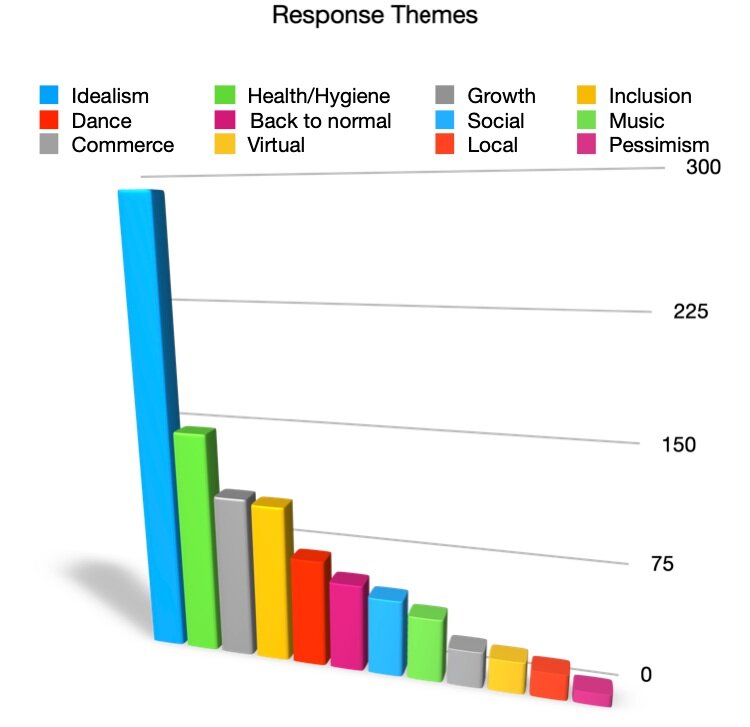
View fullsize
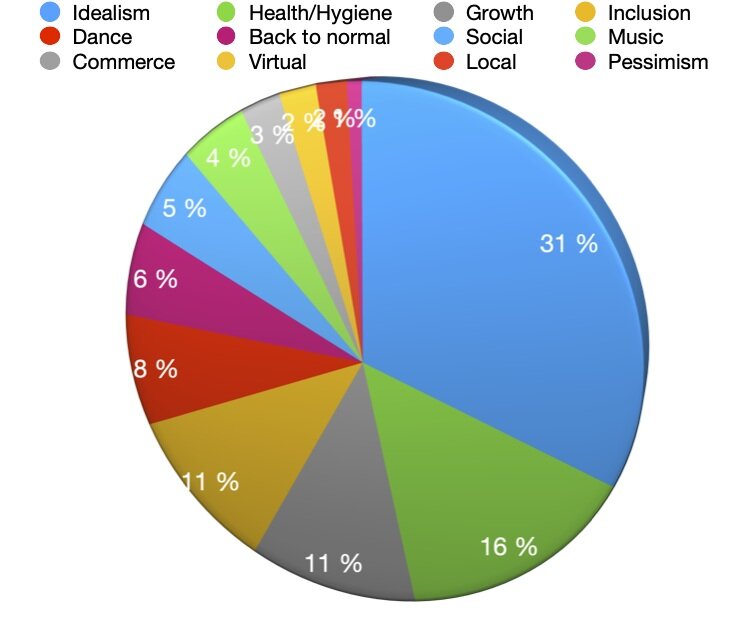
Idealism
By far, the biggest category of responses were those expressing priorities around community ideals, or the emotional/philosophical character of the activity. The thematic language of these responses is quite consistent:
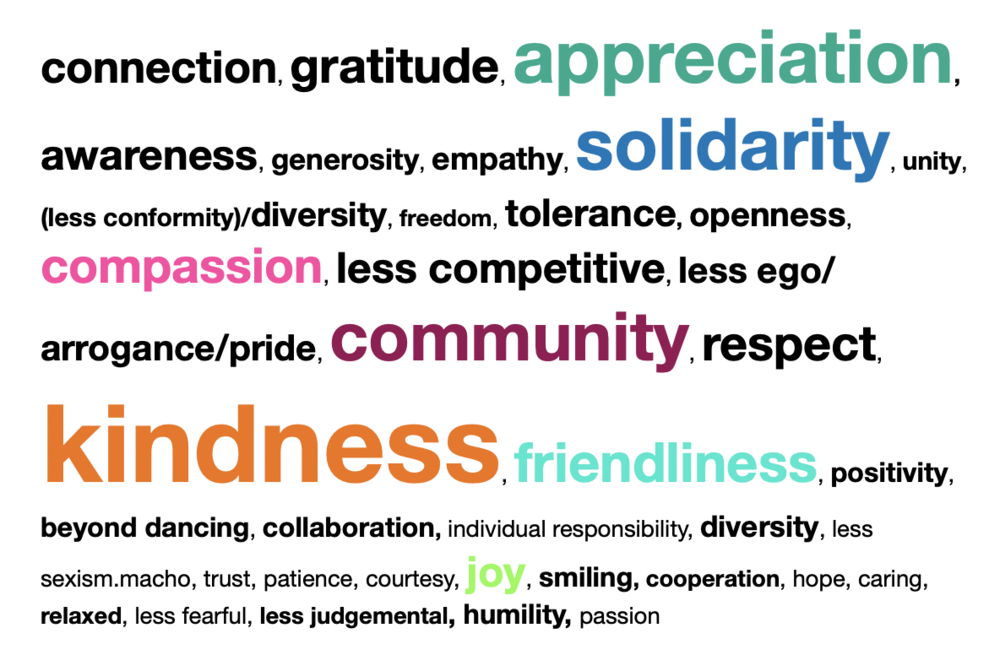
Most responses articulated the belief that the pandemic creates a potential for greater awareness and appreciation of tango’s potential benefits, with the following general themes:
-
Welcoming, social behaviours
“Gratitude for this wonderful dance we all share and less cliques and the unkind behavior that comes with it. Maybe this crisis will bring us all closer together.”
“ I hope that we really miss each other and will be more tolerant and social in the community.”
“More open attitudes to new dance partners, and activities that organizers implement to facilitate mixing prior to or during dance. A broader more integrated community is so much stronger and more resilient, not to mention welcoming. Tango can serve to connect us on many levels, not just for the purpose of having dance partners. Let’s make that a significant benefit, as opposed to a sidelined aspect. Let’s encourage networking and friendliness. “
-
Valuing diversity of people and styles
“A tighter bond in the entire community. A hope that diversity of age, skill etc. is considered a good thing in a milonga…A resurgence of the experience of tango as a SOCIAL dance & a value placed on that. Strictly social dancers who do it only for love should have equal value in the eyes of the community. Now regard seems skewed toward teachers, performers, DJs & professionals. Perhaps the loss of the community of the milonga will increase this appreciation of all who love the dance.”
“Kindness and tolerance. There’s lots of kindness in tango but due to the political situation it seems there will be less tolerance of those with different political beliefs.”
-
Prioritizing shared goals (solidarity) over competing needs
“Menos competencia y mas abrazo [less competition, more hug.]”
“La comunidad tanguera en mi país está muy dividida y es muy competitiva entre sí. Me gustaría que se uniera más y que se uniera más y trabajara más en conjunto en busca un mejor desarrollo del tango.” [The tango community in my country is very divided and is very competitive with each other. I would like it to unify more and to work together in search of a better development of tango. ]
“Tango community with less meritocratic focus, less machismo dance culture, and more supportive of fellow dancers.”
To this last point there was often a wish of more solidarity and cooperation between professionals in the community.
Many comments also extended the scope of ideals to include broader environmental, social, and economic concerns:
“what i hope to see in general coming out of this pandemic: a return to those values that count, mostly respect for our environment, be that people animals, or nature itself. get rid of that materialistic lifestyle of greed and consumption. and no – we don’t need 80 pairs of shoes and dozens of dresses, we need to be courteous to each other, dance with everybody not just our “clique”, we need to remember were tango came from and make it truly social again off the dance floor too. not an elite dance for the more affluent. “
“Intelligent consciousness; I’m hoping this experience raises awareness rather than fuelling fearful behaviors”
Some respondents portray a conflict between commercialisation and social ideals of tango:
“Awareness of others, sense of community (which has been lost during the last 10-15 years to become a “marketing market”)
“less money, more truth, more responsibility, connecting people, less narcissism, less ego.”
On the whole, however, perhaps more notable than the particular ideals expressed is the prominence of ideological or philosophical wishes that characterize so many of the responses to the question of what we’d like to see more of in tango. This raises in particular the question of building consensus around the values we’d like to embody as a community, as well as actionable steps to move towards these shared values.
Inclusion
This aspect of tango ideals/wishes was so frequently referenced that I decided to give it a thematic category of its own. Many comments expressed dissatisfaction in the current and past levels of inclusion in their tango experience.
“More inclusion of ALL dancers of ALL levels and backgrounds. We’ve come to tango for different reasons and by different means, bit we’ve stayed with it because we love the music and the connection. I want everyone to be able to enjoy that equally. “
“Tango is not generally a kind, friendly or inclusive community. I would like to see that change but I don’t expect it will.”
“Less elitism, more welcoming, asking everyone to dance.”
“More inclusiveness. Less snobbery. I love tango. My favorite thing. However, women communities are extremely elitist and its makes something beautiful into an unpleasant experience.”
Others present the complementary side of this dynamic:
“Drop the stigma of rejecting a tanda – I choose who to breathe with for 12 min.”
“Less pressure to dance with others.”
A few comments address this theme as a personal goal to be more inclusive/generous:
“finding ways to authentically enjoy dancing with a wider variety of partners/music.”
Some responders noted that the theme of inclusion has both dance and non-dance aspects, and in a few cases the distinction of being socially inclusive while being selective with dance partners is presented as a way to address the topic.
As a group, Inclusion represents a higher percentage of female responders compared to the survey population as a whole (78% vs. 65%). Geographically, this theme is more prominent in North America, less prominent in Europe. Comparing by country, percentage of inclusion themed responses from the USA is substantially higher then the general survey pool (74% v. 57%), conversely, while Germany represents 10.5% of the general survey population, only 3% of the Inclusion themed responses come from Germany.
As a dancer with many years of milonga experience in both countries, I’d suggest this difference reflects less the actual social/dance experience in the milonga, and more the prevailing myth or expectation of the dance community. In other words, I don’t take the under-representation of comments from Germany in this theme to suggest that German milongas are more inclusive, but rather that dancers in Germany don’t have the same expectation of inclusivity, and are thus less likely to express disappointment with their experience. Conversely, I don’t experience milongas in the US as being less inclusive then in other parts of the world, but I believe the story of everyone dancing with everyone else is stronger in the US, and there is more expression of disappointment when this expectation doesn’t match the milonga experience.
Inclusion group All Responders
View fullsize
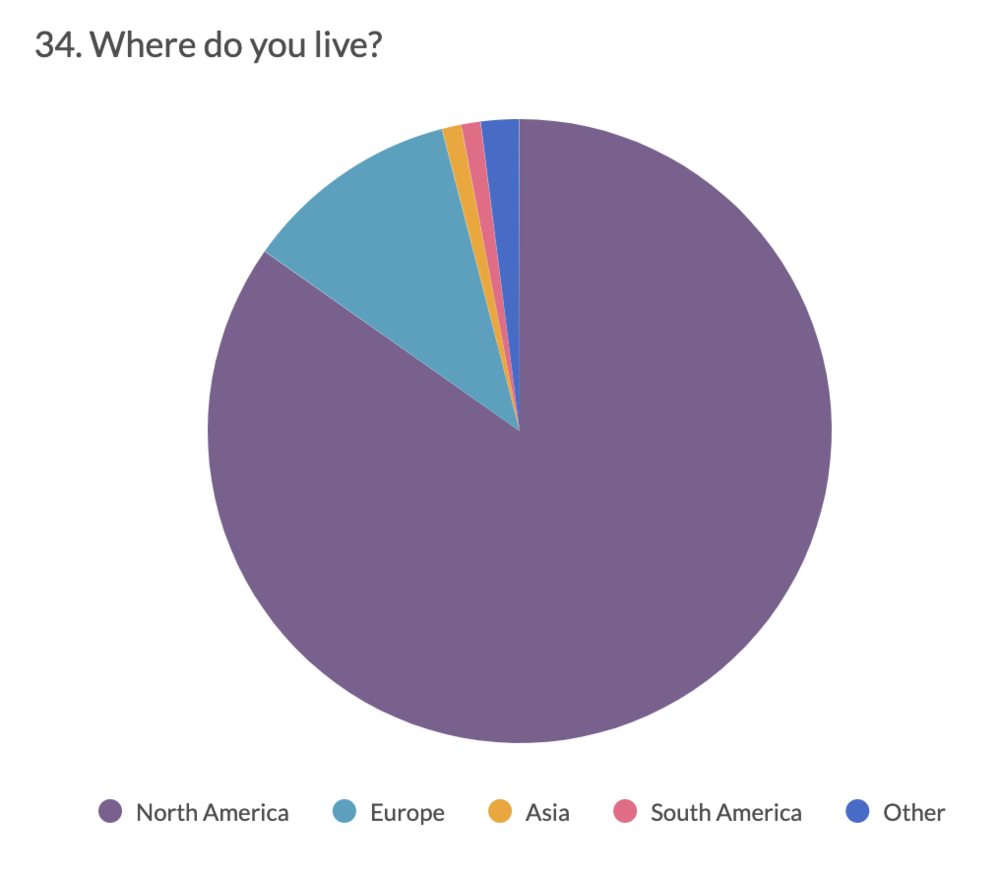
View fullsize
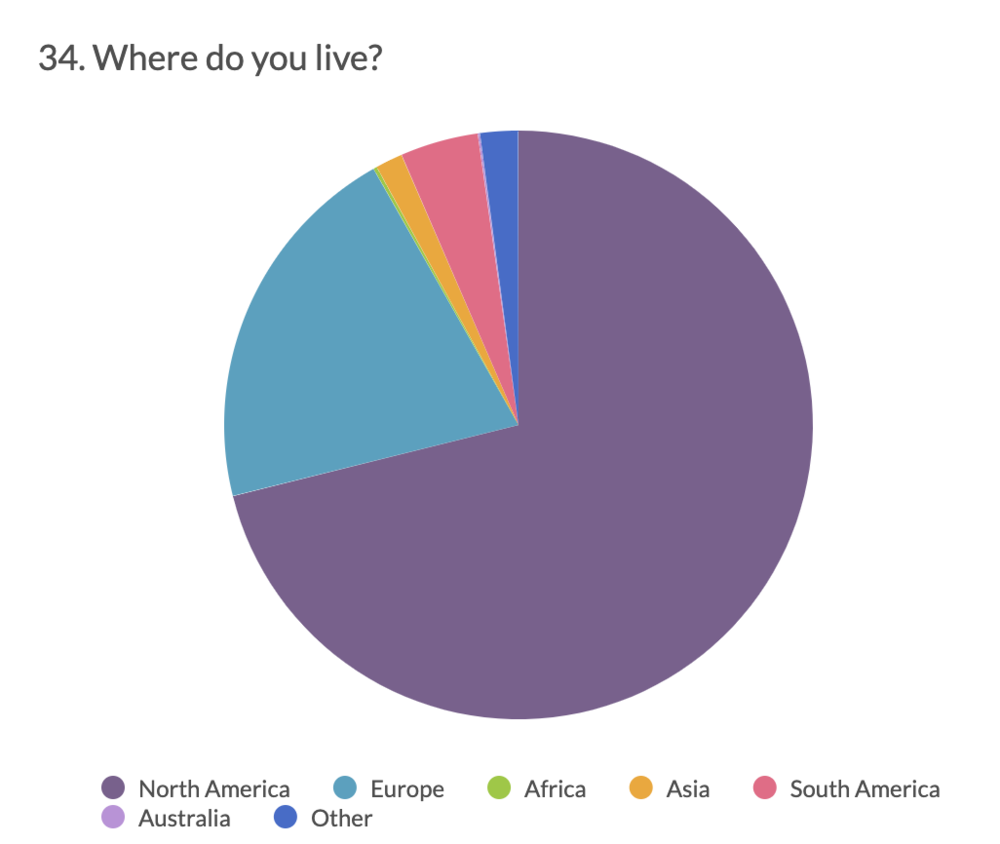
View fullsize
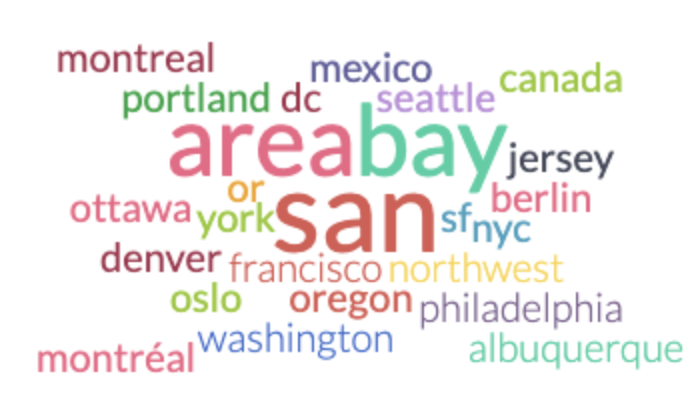
View fullsize
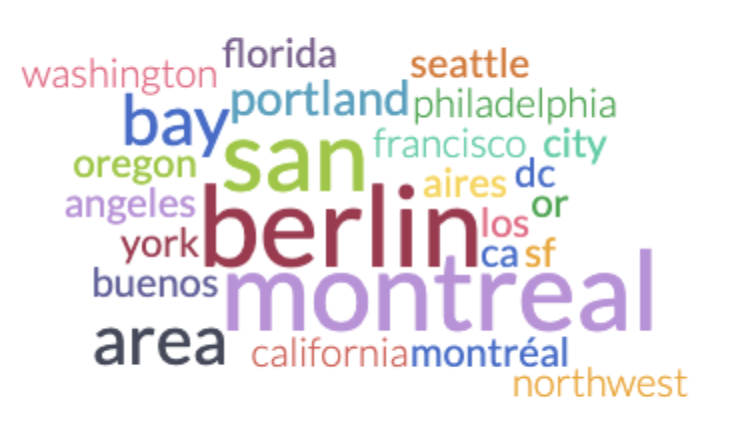
The topic is relatively neutral to community size, but the Inclusion theme is slightly more prominent in communities with less than 500 (75.5%vs. 69.8%) dancers, and rather notably less present in communities with more than 1000 (12% vs. 17.2%).
View fullsize
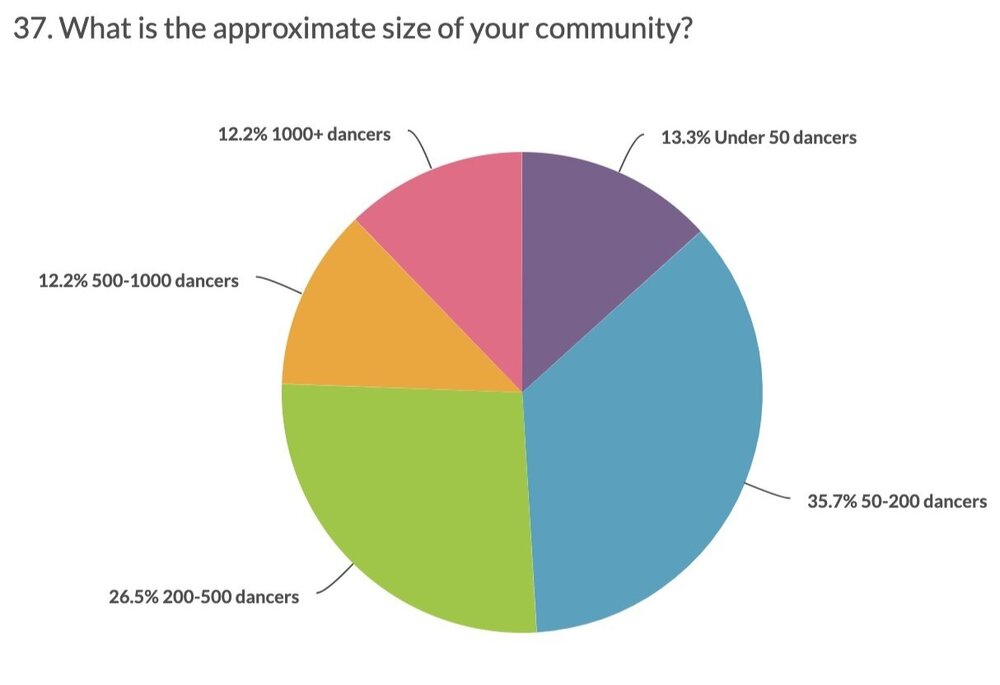
View fullsize
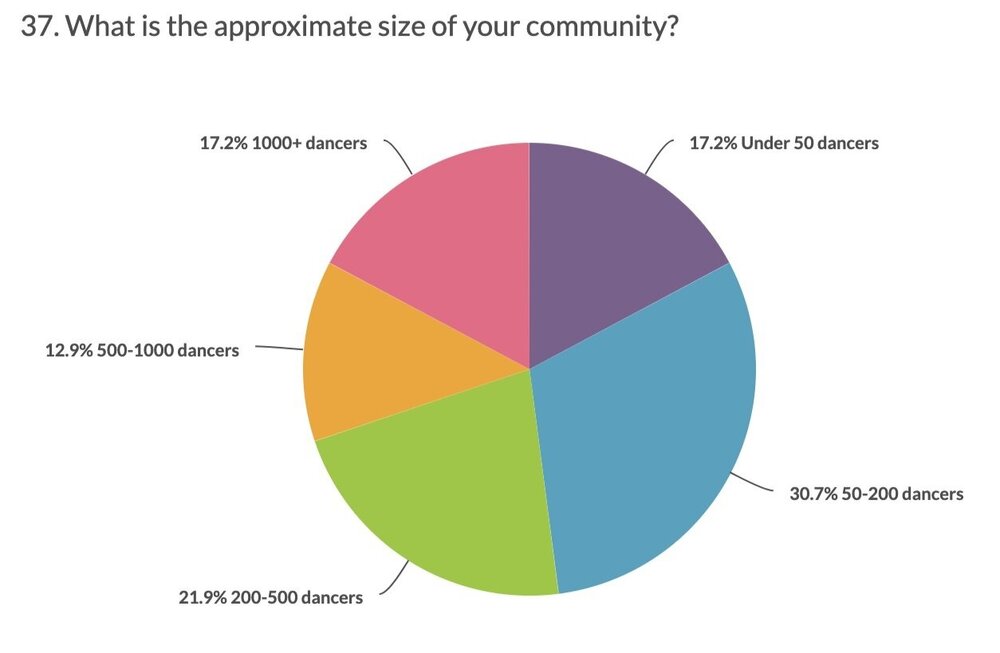
Collectively, the responses in this category invite reflection and discussion. It’s clear that for many dancers this theme presents an unmet expectation and a diminished experience of tango. Polarities in this theme that emerge from the collected responses include:
-
individual preference/pleasure vs. group dynamic as underlying behaviour motivation;
-
personal agency vs. collective social obligation in remedying the situation;
-
perhaps on a fundamental level: freedom vs. equality;
-
perceived and sustained social and dance hierarchies: a natural condition of the tango ecosystem or a flaw to be improved upon?
Health and Hygiene
About 17% of responses focussed on issues of health, safety, and personal hygiene as the one thing they wanted more of in tango’s future. A vast majority of responses expressed a wish for individual responsibility in staying home when feeling sick.
“More individual awareness of and responsibility for public health and the health of others in the community. Don’t come out if you’re not feeling well, even if you really want to dance and see your friends.”
A number of responses in this group described past experiences where this expectation was not met.
“Social responsibility. Before, people would come to classes with colds and mild illness, but I hope people will stay home more if they are sick.”
A number of responses referenced the wish/need for a vaccine as a condition of a return to dancing.
“Responsible behavior: Getting vaccinated and providing proof. Getting tested for the presence of COVID-19 and of antibodies, and providing proof. Wearing a mask at least off the floor Keeping a distance.”
Other popular themes include hand washing, ventilation, open air dance events, masks…the following quote is a pretty good summation of the topic:
“More washing hands in general and more open style and more fresh air in the dancing locals and more respect for illness, don’t dance if you are not well no matter what just because YOU want to dance”
As tango consumers this group was fairly representative of the general pool of responders in frequency of milongas and festival attendance, but monthly spending in this group is a bit lower then the general poll group and this group is, not surprisingly, spending less now relative to the full group.
Health/Hygiene General Poll Population
View fullsize
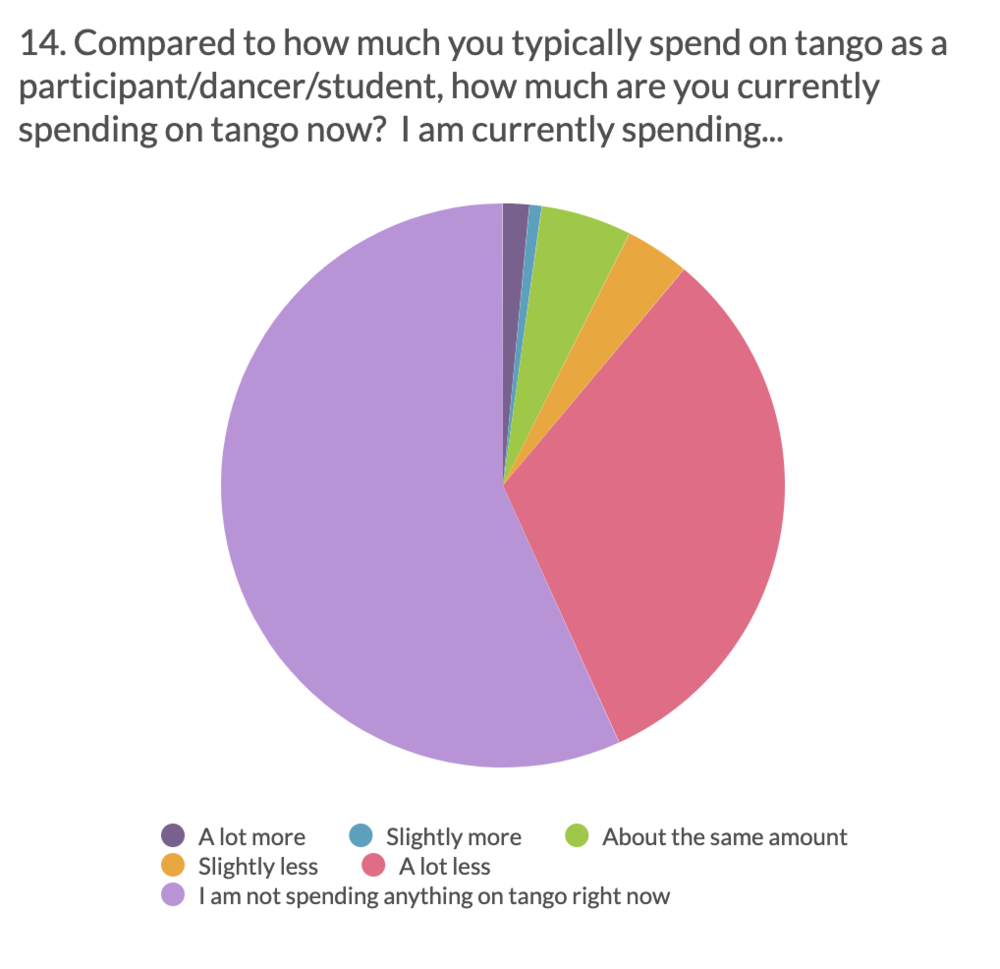
View fullsize
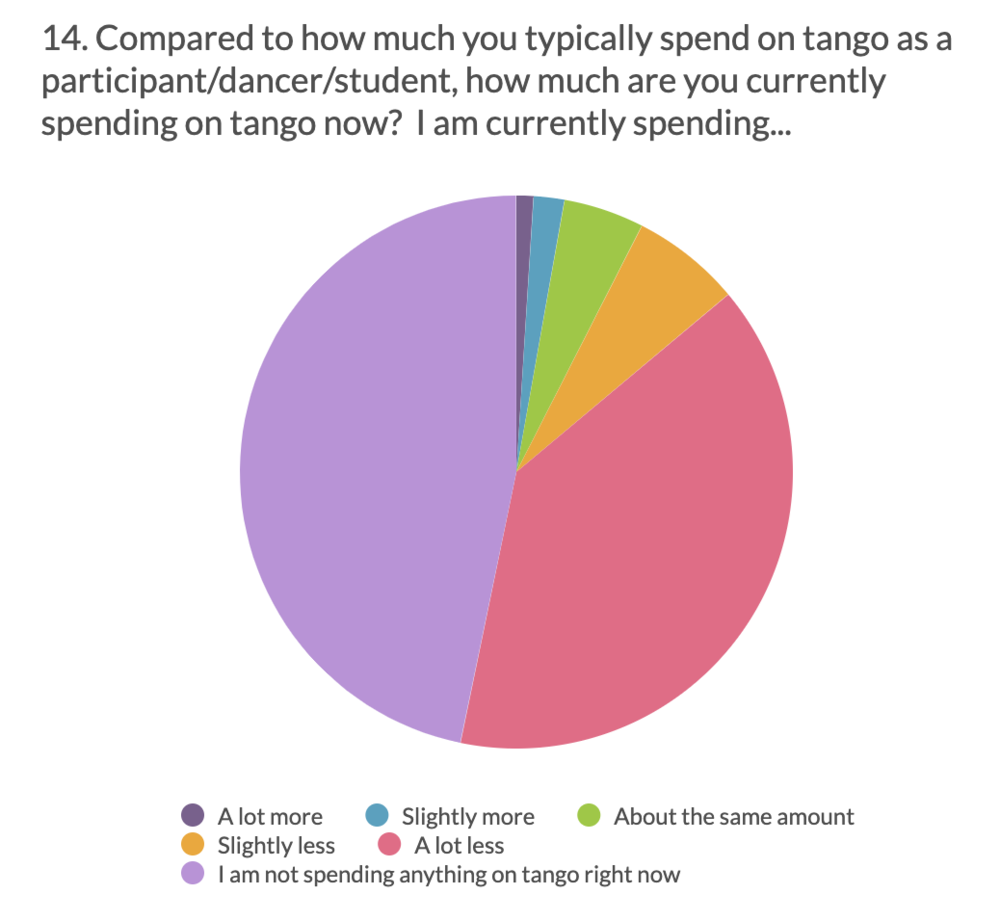
This group has a higher percentage of women than the general poll group (73% vs. 65%). Geographically, the Health/Hygiene group gravitates towards North America with 87% vs. 71% of the general group.
Growth
What do we want to see more of in tango? This group wants to see more tango! About 12% of responders expressed themes related to the expansion of tango post Covid-19: More dancers, more milongas, more classes, more women, more men….generally just more. Also included in this category are wishes for evolved teaching methods and expanded subject matter.
“More lectures and discussions about tango in addition to classes…it has been educational to learn about broader aspects of tango- cultural, musical, etc”
“Creative programming and panels like Tango Poetry Project”
“equal instructional value for followers”
Some responses describe countering a perceived lull or gap after the pause, others express the need for growth as a constant concern in their tango world view.
Demographically, this group skews towards North America, and dance communities between 50-500 dancers (curiously in communities with less then 50 dancers this view is under-represented).
Growth Group General Survey Population
View fullsize
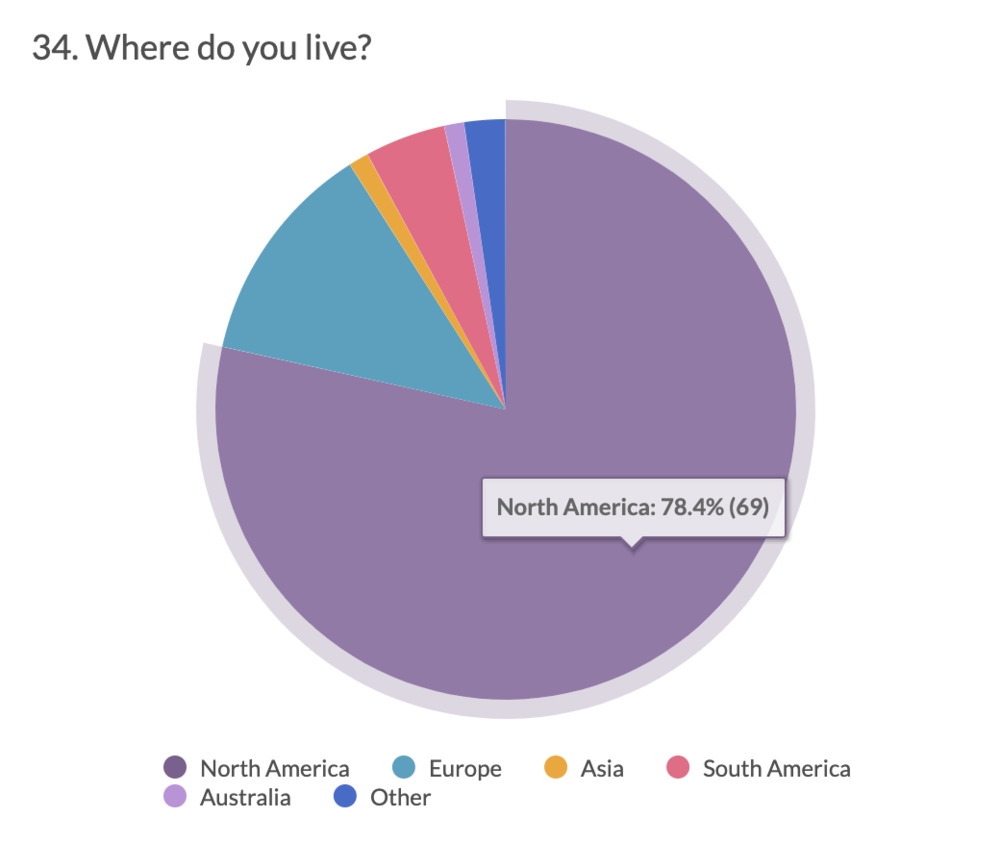
View fullsize
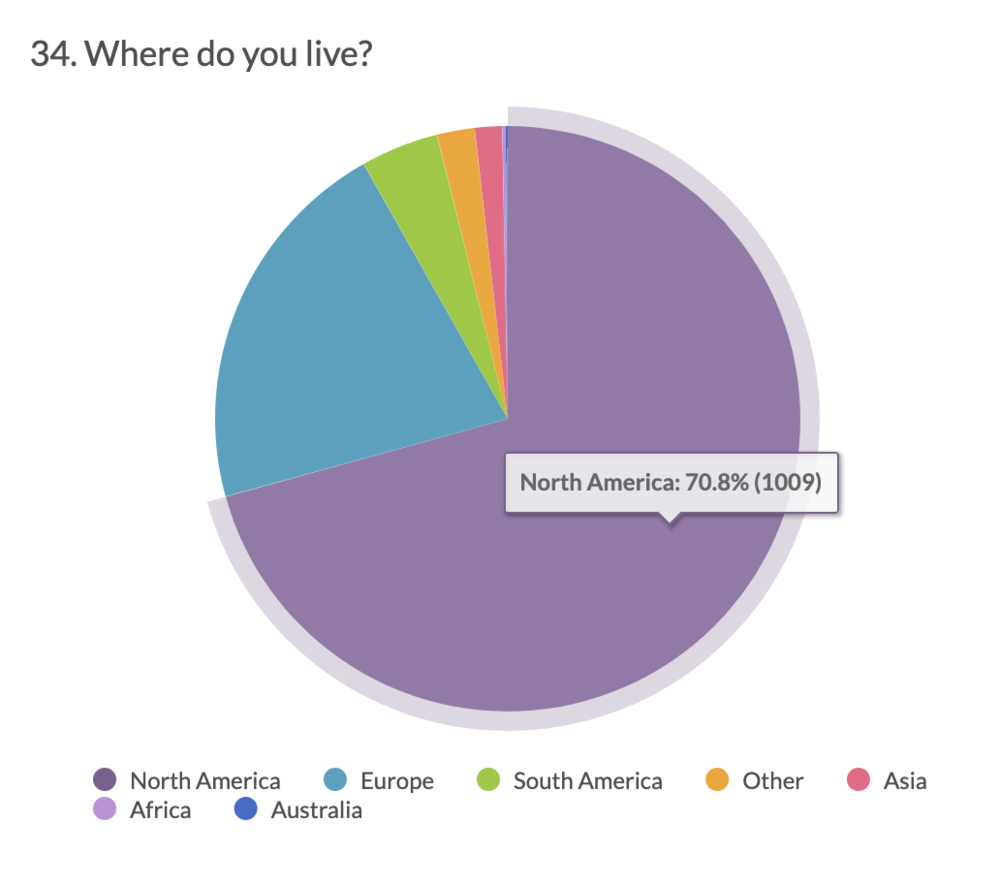
View fullsize
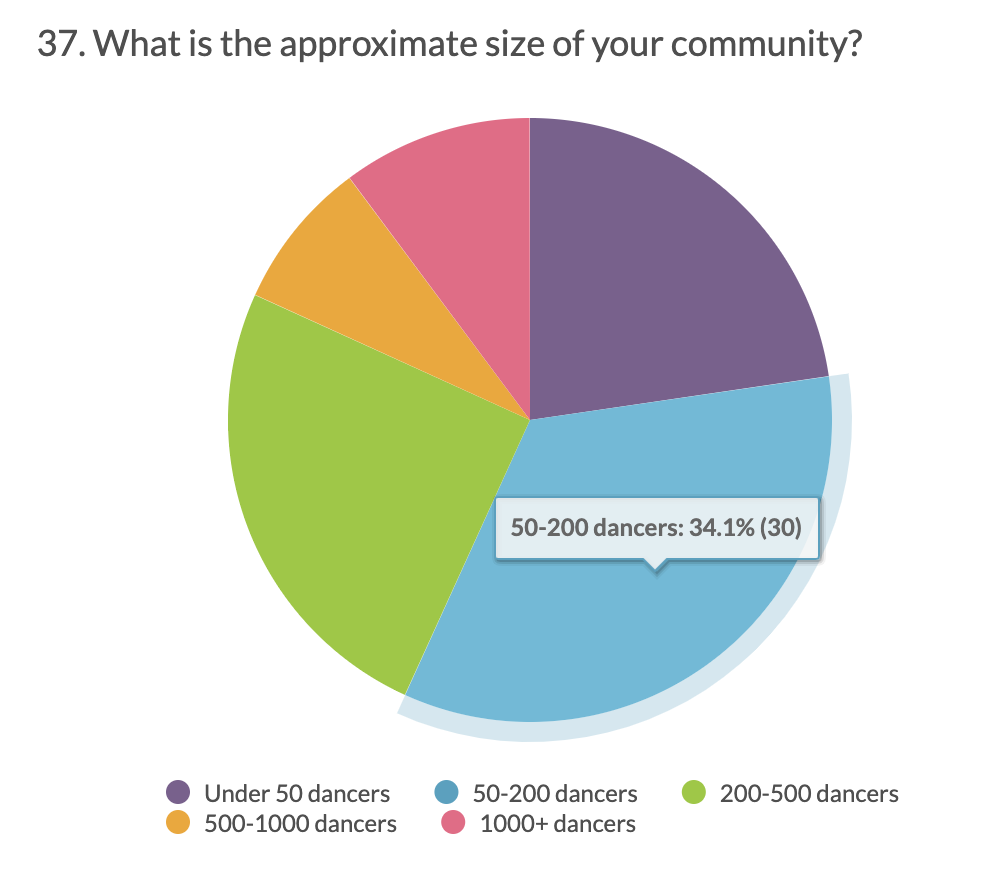
View fullsize
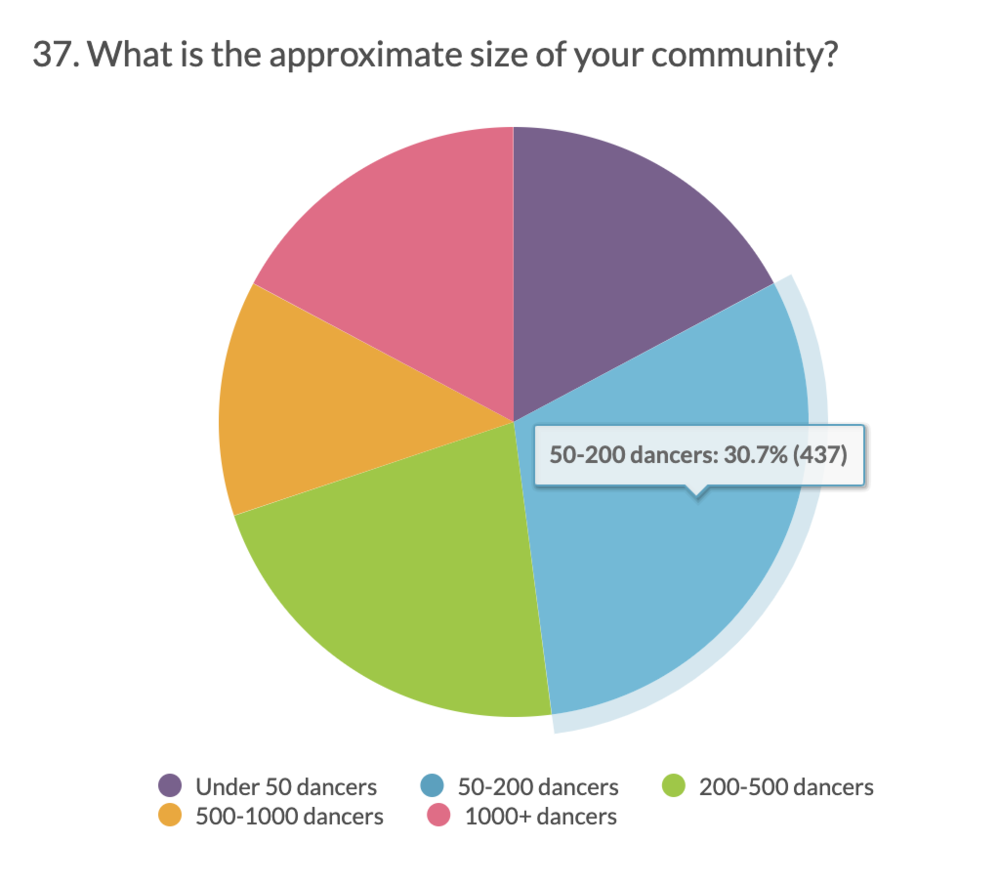
Dance
A focus on the dance itself was represented in about 8% of the responses. General themes include improved level of dance and dance technique, improved floor craft at milongas, and dancing in both roles.
“More effort to improve skills”
“Women leaders”
“More lead/follow switching, more openness to dancing with new partners”
“Quality dancing with emphasis on appreciating and dancing to music rather than mechanical dancing”
Responders here also refer to some of the themes seen in other categories but through the lens of dancing:
“That people are willing to put in effort to dance well. That everyone gets to dance”
“Less talk, more dance. I don’t want to see or hear anything divisive or political.”
“Less tango championships, less competition and more joy-oriented dancers behaviour.”
In some cases, the ideals expressed by many as social or philosophical goals appear also in dance-centric responses:
“Touch!!! Not just sitting a hand on a shoulder, but melting into the other person. And kindness.”
The group of Dance responders reflects a much higher percentage of dancers who chose “Social dancer – leader” as primary role vs. the general survey population. This group also presents a higher percentage of dancers with more years of dance experience, compared to the general survey population.
Dance Group General Survey Population
View fullsize
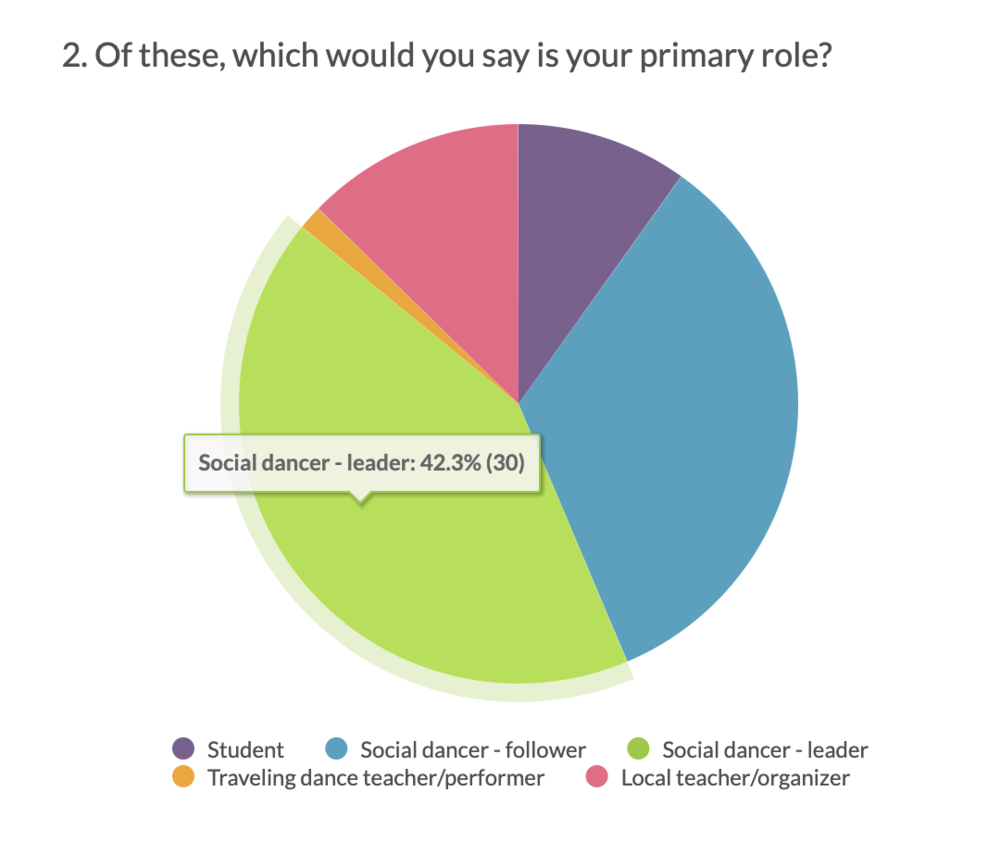
View fullsize

View fullsize

View fullsize

This group represents higher then the general population in medium sized communities (between 50-500) and much lower in communities over 500 (20% of the dance group vs. 30% of the total responses.
Social
A number of responders focussed on the role tango plays in their social life. These responses share many themes with the Idealism category, but express more of an individual experience than a goal for the community as a whole. The oft repeated theme – “I just want to get back to meeting my friends.” This confirms a perception reported elsewhere that tangos importance for many, extends beyond the dance experience. It also sheds light on another facet of the Inclusion topic, revealing how important the immediate circle of person connections is for some tango participants, as contrasted to the general socially inclusive environment of the milonga.
Normalcy
About 6% of the responders indicate what they’d most like to see in post-COVID tango is simply what existed pre-COVID.
“That it returns to normal and nothing else.”
“Nada, al tango no le falta nada.” [nothing, tango is not missing anything]
“À partir de mes expériences et mes goûts; rien ! C’était à la fois inspirant, satisfesant nourrissant plusieurs sens” [From my experiences and my tastes; nothing ! It was both inspiring, satisfying and nourishing several senses]
In general this group expresses complete satisfaction with their pre-COVID tango experience, and in some cases even wariness of the possibility that tango might change. Demographically this group is quite similar to the full survey group regarding location, community size, years of dance experience, level of activity and roles in tango. The primary difference between the Normalcy group and the survey group as a whole is gender, with men accounting for nearly half the Normalcy group as opposed to about 1/3 of the total. This group also reports a higher degree of negative impact to well being with the absence of tango.
Normalcy Group General Survey Population
View fullsize
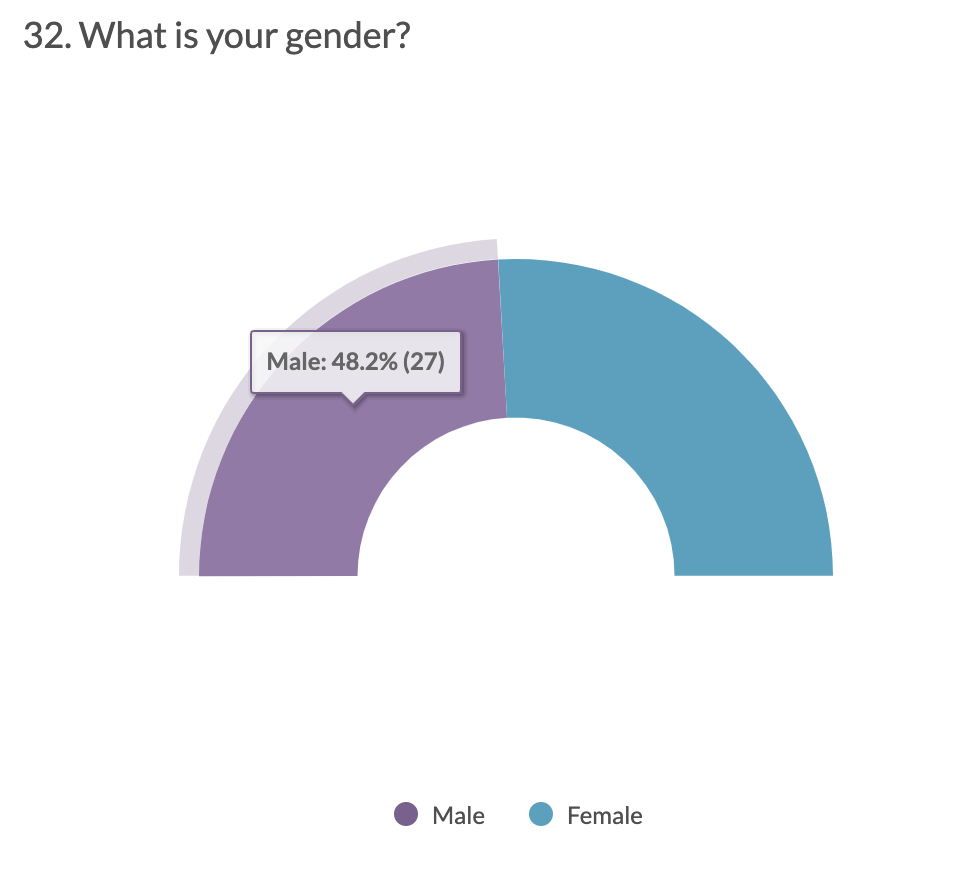
View fullsize
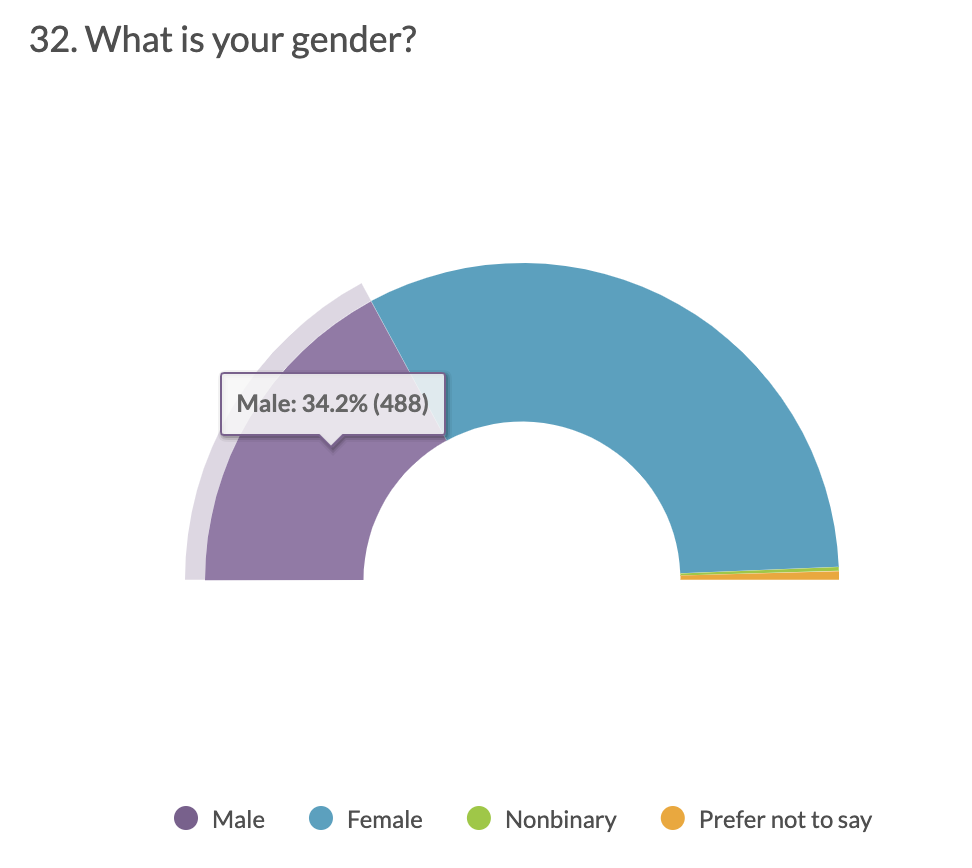
View fullsize
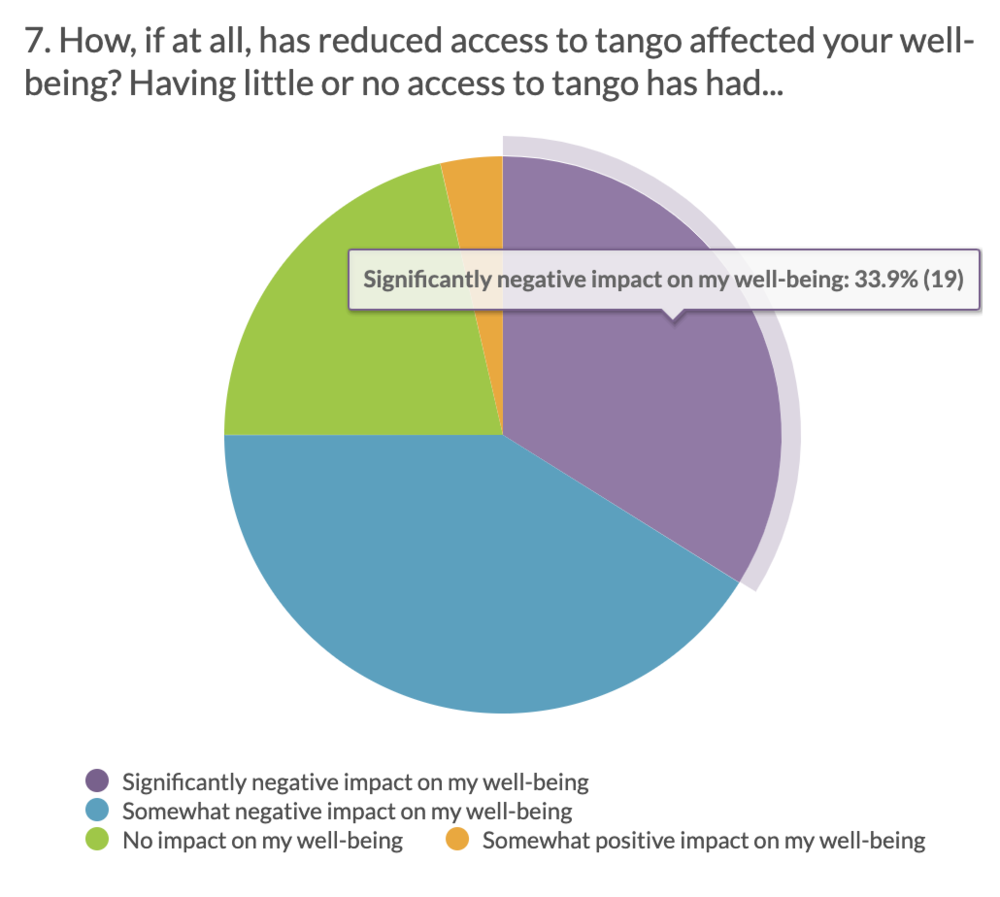
View fullsize
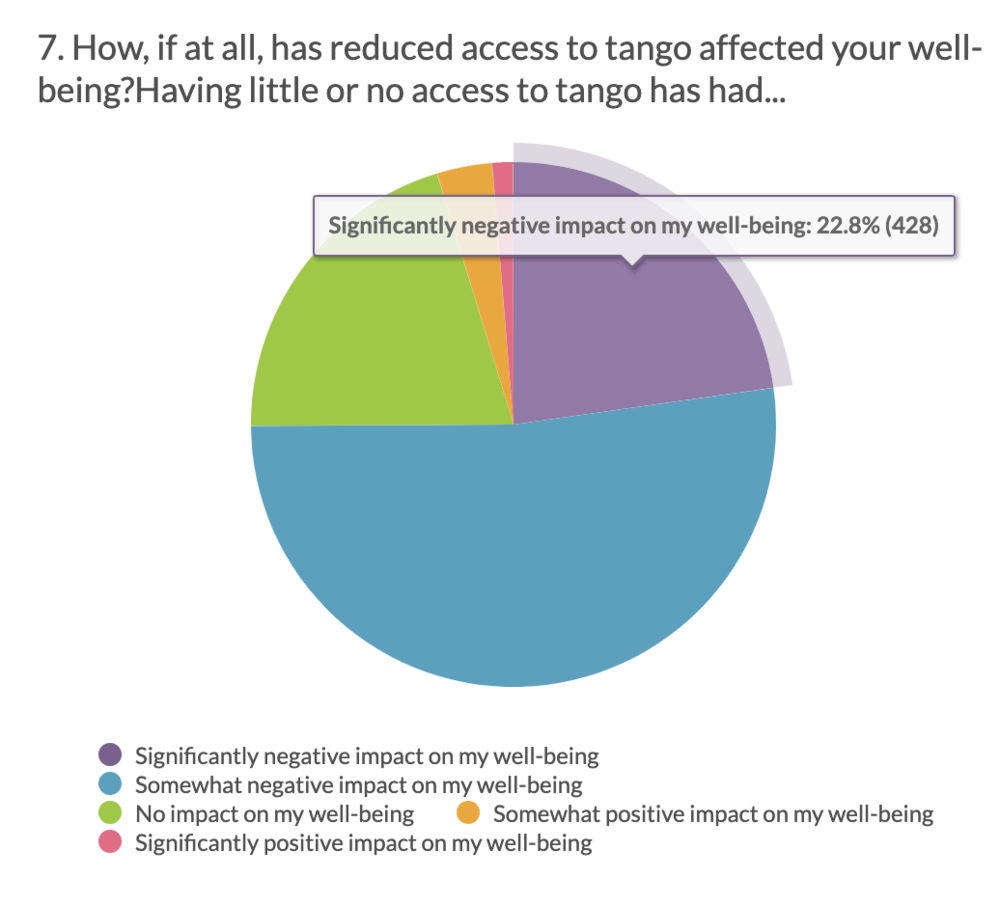
Music
About 5% of responders reported something related to music as the one thing they’s like to see more of in post-COVID tango. Most of these responses mentioned live music. Other themes include teaching around music, new tango music, and alternative music.
Commercial Ecosystem
Responders in this category focussed on the financial/professional aspect of tango post Covid. The term Commercial Ecosystem points to underlying themes in these responses relating to sustainability and acknowledging/valuing the work of tango creators. These comments address interdependencies of financial health and societal valuation.
“respect for serious organizers”
“Valorización de los artistas como trabajadores” [Valuation of artists as workers]
Responders represent both consumers and producers and the perspectives voiced are both cautionary about monetizing tango:
“When it comes to tango, I’d like to see less of some things and practices such as elitism, viewing people as cash cows, jam-packed milongas with little concern for health and safety…”
as well as the importance of sustainable pricing:
“Las milongas que están subvencionadas , que cobren un precio único y popular. Y las milongas que eran gratuitas, dejen de serlo.” [The milongas that are subsidized, should charge a unique and popular price. And the milongas that were free, stop being free]
Amongst those earning income, this group has a much higher proportion of those making most of their income from tango. The group also has a significantly higher representation of dancers with over 11 years of experience in tango.
Commercial Group General Survey Population
View fullsize
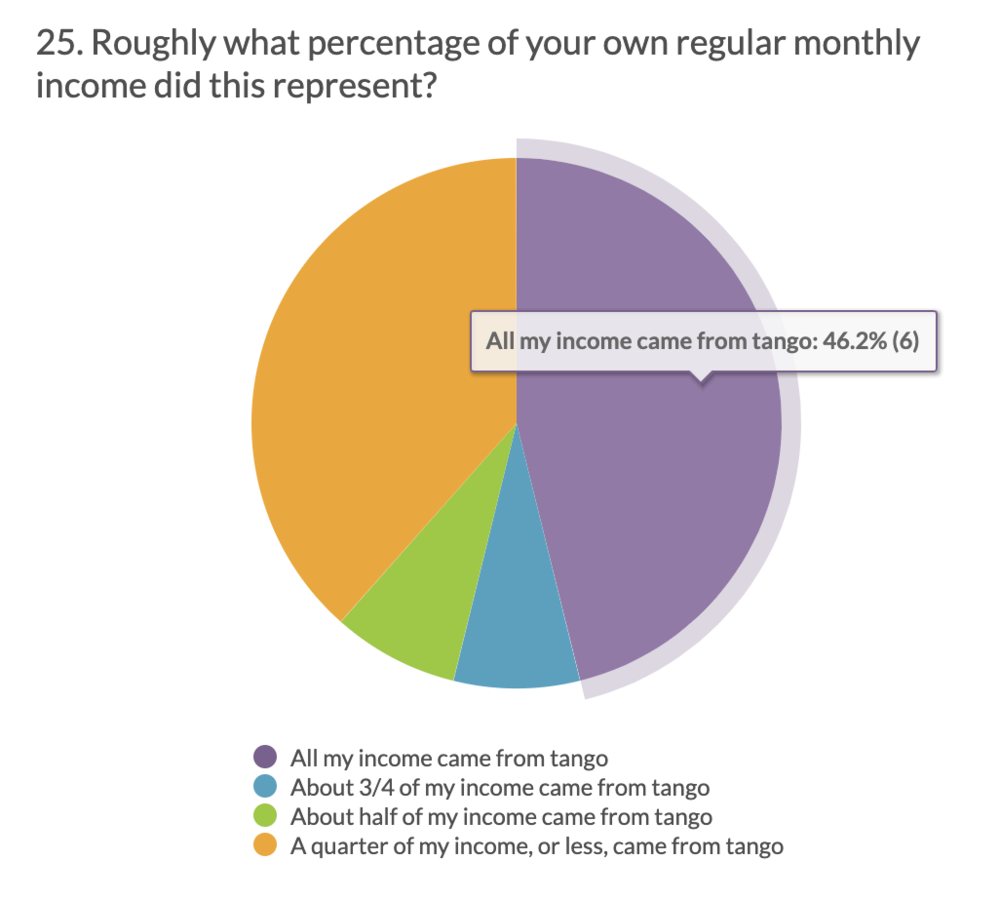
View fullsize
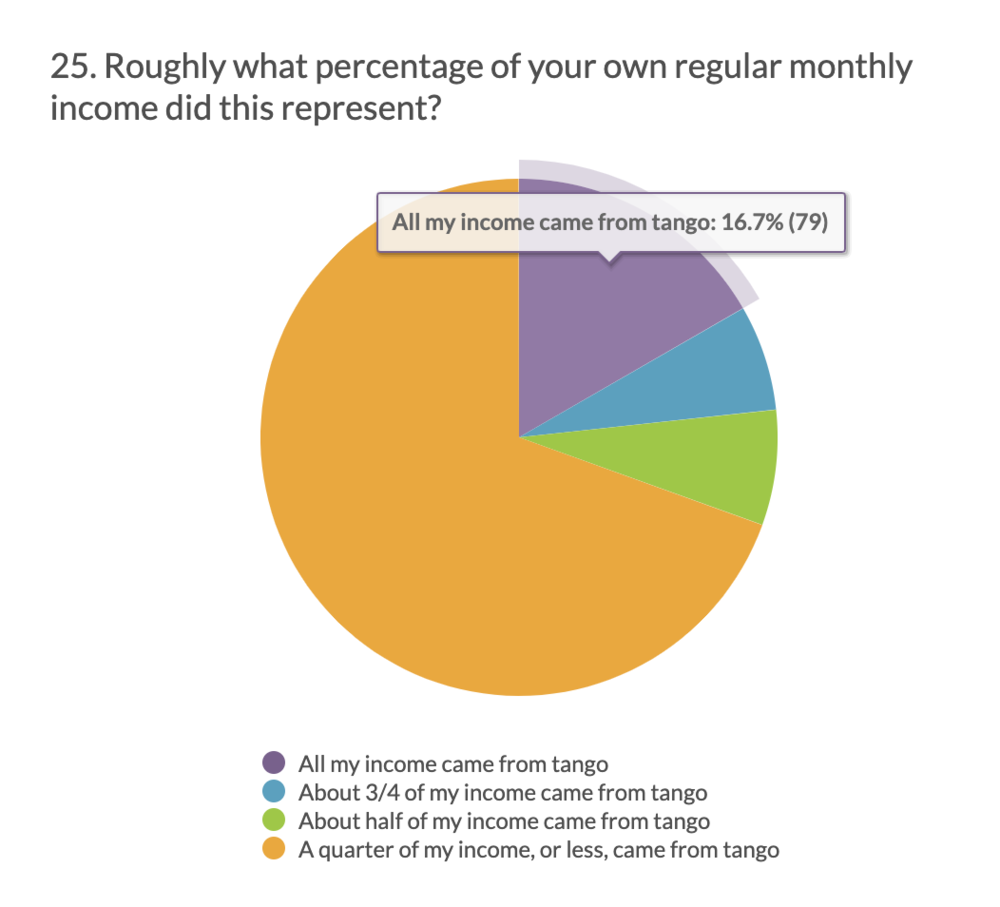
View fullsize
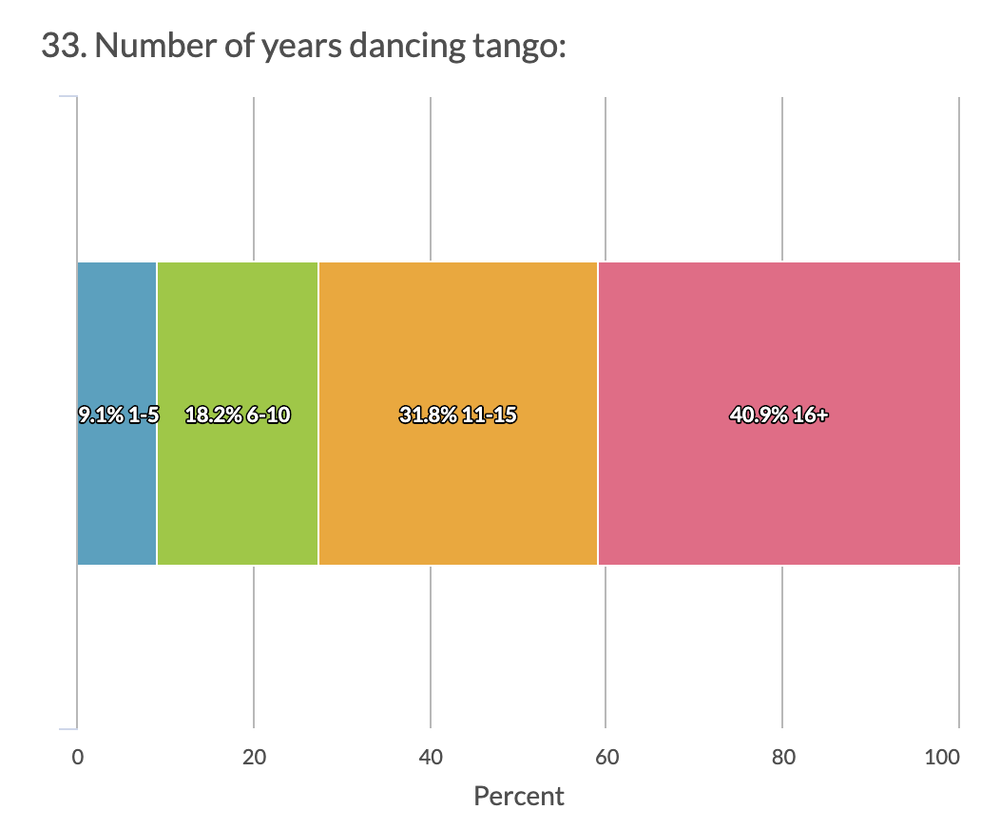
View fullsize

Other themes
The continuation of Virtual or On-line tango opportunities was mentioned in 21 comments. In nearly all cases this was viewed as a positive innovation of the pandemic tango experience that should be continued post pandemic. 17 respondents focussed on the theme of local tango events versus tango travel, citing health, environmental and social reasons for preferring a more localised, smaller scale tango experience. Finally, there was a small group of responders who’s answers to the question was generally pessimistic, expressing doubt that a vibrant, enjoyable tango experience would resume.
Conclusions
Difference, Contrast, Opposition, are common themes in tango dance and tango discussion, so it’s not surprising that when asked about wishes for the future or tango some familiar tensions emerge. Individual v. Community, Art v. Social Activity, Tradition v. Innovation, these are valances that are often active in tango thought and culture. Even looking at the broader idea of “social dancing,” one confronts all of these tensions in just two words. Is it more about aesthetically meaningful movement and a pursuit of dance excellence, or is the social aspect (group experience) the defining characteristic? What I find revealing and remarkable from this collection of tango perspectives is the prominence of idealistic, community oriented answers. These answers reveal topics that invite further investigation, and perhaps an opportunity for better understanding of the diversity of needs amongst tango stake-holders. The following quote nicely encapsulates many of the wishes expressed in response to this survey question:
“More solidarity and common open kindness in milongas to replace ego and competitiveness. I hope that people will consider the importance of supporting local teachers and milongas and not only traveling for tango. I hope organizers focus more on the cultivating a welcoming culture of inclusion in their events, which will lead to more financial success and longevity. I hope teachers and organizers everywhere focus more on growing the pie, rather than only getting a bigger piece. So many more people could be falling in love with tango if everyone takes the ego down a notch or two. There should be more focus on fun and enjoyment than competition“